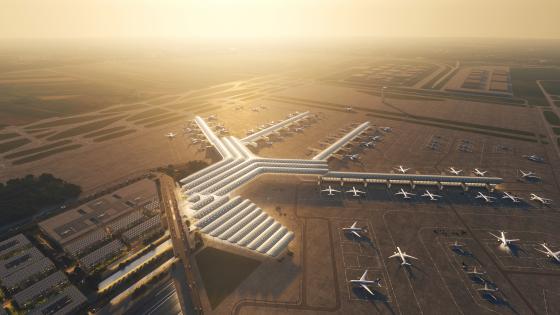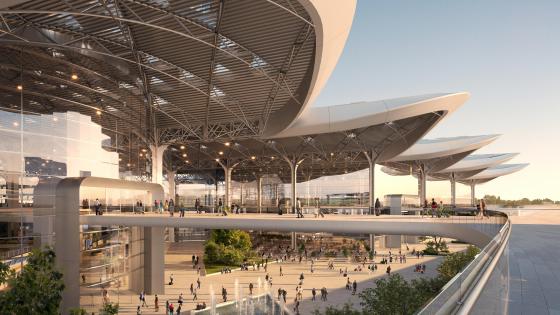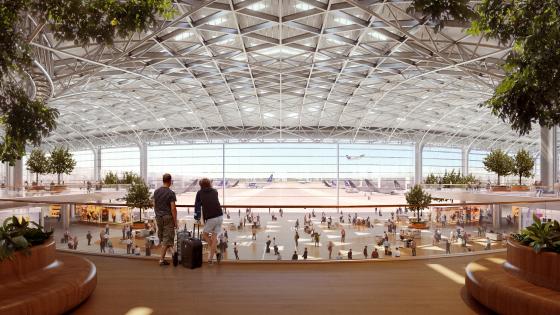Poland’s Centralny Port Komunikacyjny, a greenfield multimodal hub at the heart of Europe, is ambitious but on track, reports Tara Craig.
Construction work will officially begin this autumn on one of Europe’s most ambitious transportation projects, Poland’s Centralny Port Komunikacyjny (CPK) airport and railway node.
Earlier this year the European country’s Minister of Infrastructure approved CPK’s General Plan. Design concepts were chosen by the company and the public was shown how the passenger terminal, main railway station and interchange would look. Some 250 architects and experts worked on the project, including the master architect, the Foster + Partners consortium.
Our goal is to carry out the project in a manner that is optimal for the region
A focus on the environment
Poland’s Regional Directorate for Environmental Protection (RDOŚ) subsequently ruled in favour of building CPK, enabling the company to apply for a location decision and then a building permit.
RDOŚ’s decision relates to the passenger terminal, buildings and facilities supporting the operation of the airport, air traffic control tower, runways and taxiways, aprons, rail and road nodes, as well as the associated infrastructure, such as hotels, commercial buildings and car parks. It also allows CPK to remove trees and shrubs, and carry out geological works and the required archaeological and maintenance tests.

The new airport will be built 37km west of Warsaw
“The environmental decision issued by RDOŚ in Warsaw means a green light for building CPK with respect towards the people and the environment. Our goal is to carry out the project in a manner that is optimal for the region,” said Marcin Horała, deputy minister of funds and regional policy, government plenipotentiary for CPK.
This regional approval is significant – as Horała implies, sustainability is key to the project. Speaking to Airports International last year, he said of the new airport’s planned location, 37km west of Warsaw: “The site has been selected with environmental criteria in mind. Its impact on the ecosystem and biodiversity has been minimised. Within a radius of dozens of kilometres from the proposed airport there are no protected areas, and few forests.”
This commitment to sustainability can be seen throughout the recently published Master Plan, which works on the assumption that the airport should operate on a net-zero CO2 emission basis from its launch date. To this end, it will use zero-emission vehicles for ground handling and will source energy from renewable sources.
We intend to provide passengers with opportunities for seamless travel by combining different modes of transport in one place
Transparency and ambitions
The Master Plan was developed to provide guidance for designers and contractors and is a key source of information on the development of a multimodal hub that integrates air, rail and road transport. It outlines the project’s vision and strategic objectives in terms of the location, sustainability initiatives, airport layout and phasing for all key areas, including airside, passenger terminal, railway station, landside area, cargo area, MRO (maintenance, repair, and operations) space, and other infrastructure.
Only one of Poland's 15 public airports – Katowice Airport – has to date published its master plan online. To give this some context, in the UK, 30 airports have made theirs public, CPK noted.

The airport has been designed with minimum walking distances and level changes in mind
“The publication of the CPK airport Master Plan ensures that the assumptions and plans for the construction of this much-needed investment are transparent and publicly available. It is also the next step in the investment process. We have moved from the planning stage to the advanced design,” said Horała.
Mikołaj Wild, president of CPK, described the document as the result of “months of work on the long-term development concept for the airport and the multimodal CPK hub”. He added: “We intend to provide passengers with opportunities for seamless travel by combining different modes of transport in one place. A key element of the designed infrastructure is the first railway station integrated in such a way with the airport.”
The document outlines the different phases of the CPK airport development: from its launch, which is planned for 2028, through the subsequent stages until 2060 – the end date of the aviation forecast for the Polish market created by the International Air Transport Association (IATA).
The need for flexibility
The Master Plan is in line with IATA's forecasts, which were created assuming three scenarios – low, baseline and high – taking into account the impact of the COVID-19 pandemic. According to the baseline scenario, the 40 million passenger level should be reached around 2035, which would indicate a need for infrastructure expansion. In 2060, it is anticipated that nearly 65 million passengers per year will be using CPK. Transfer traffic is forecast to account for around 40% in the initial period of the airport's operation and to increase to between 45 and 50% in the long term.
The plan notes how flexible design means it will be possible to expand the terminal, aprons and other infrastructure in a modular way. On opening, the CPK airport will have two parallel runways, each 3,800m long, separated by a 2,500m midfield where the necessary infrastructure will be located, including a passenger terminal with a multimodal hub and a railway station, aprons and de-icing pads, as well as an air traffic control tower. Space for future expansion and a third runway can be found to the south of the site allocated to the two runways already designed.

According to IATA forecasts, the new facility will be handling nearly 65 million passengers per year by 2060
The station
A railway station with six underground platforms serving long-distance, regional and commuter connections will be integrated with the terminal.
The railway line, which will be put into service to coincide with the opening of the airport, will connect Warsaw and Łódź with CPK, plugging the airport into Poland’s high-speed railway system. The CPK station is the centre of a railway node connecting the airport with lines to Warsaw, Łódź and Wrocław, Poznań, Kraków and Katowice, Tricity and Rzeszów. Travel times between the CPK airport and the largest cities in Poland should not exceed 2½ hours.

The architects adopted a functional design philosophy, while demonstrating the character of the region
The results of the passenger transport model (PMT) forecasts indicate that around 40% of passengers will commute to the airport by rail, with some 50% using cars and taxis and the remainder using buses and other modes of transport. In the longer term, there are also plans to extend the Warsaw Commuter Rail (WKD) line from Grodzisk Mazowiecki to the CPK passenger terminal.
Two additional railway stops will be built within the airport, operated by regional trains. The CPK East stop will provide access to the Airport City (hotel, office, conference and administrative facilities). The CPK West stop will serve a cargo zone (the CPK Freight station is to be built in the western part of the interchange). The cargo terminals for airfreight are to be located on the western side of the airport.

Environmentally-friendly and energy efficient, CPK airport was designed with a “silent airport” approach
The Master Plan also takes into account the preliminary road layout around the airport, which is undergoing in-depth analysis and agreements with the General Directorate for National Roads and Motorways (GDDKiA).
The finished product
Once complete, CPK airport will be a digitally and technologically-driven space. Passengers will benefit from an accessible and family-friendly design, while flow-through architecture will ensure intuitive wayfinding. Energy efficient, it will be full of plants and natural light, reflecting the developers’ ongoing commitment to both passengers and the environment.
